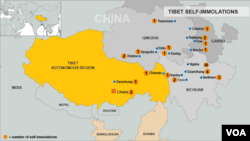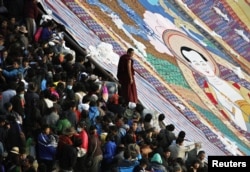Just outside Tibet’s capital, Lhasa, the Chinese government is building a $4.7 billion theme park that critics describe as a fairy tale universe that trivializes Tibetan culture and glosses over the nation’s troubles.
The construction gets into high gear as Tibetans continue to demonstrate and set themselves on fire to protests Chinese policies in the nation Beijing invaded 63 years ago. The 50th such self-immolation took place this week.
The Chinese Embassy in Washington refuses to comment on the theme park project, or the self-immolations. But Beijing’s official news agency, Xinhua, quoted the deputy mayor of Lhasa, Ma Xingming, as saying the project “is designed to improve Tibet’s tourism credentials and be a landmark of the cultural industry.”
Xinhua said the park, scheduled for completion in three to five years, will be centered on the theme of a Chinese princess who marries a Tibetan king. It said the park will include displays of Tibetan handicrafts, medicine and folklore.
Tenzin Dorjee, Executive Director of Students for a Free Tibet in New York, is not impressed, noting that the project comes as Tibetan activists continue to protest Chinese dominance of their homeland.
“They are spending these billions of dollars in building a theme park in Tibet at a time when Tibetans are setting themselves on fire for freedom,” Tenzin said. “And this is China’s way of not addressing the problem, not addressing any grievances.”
Tenzin also accused Beijing of trying to distort Tibetan history by highlighting its own version of the nation’s past.
Stephanie Brigden, director of the London-based Free Tibet campaign, is another critic of the Chinese project.
“When you look at the proposed scale of the theme park, it’s vast and it’s … a strategy of ‘Disneyfication’ of Tibet,” Brigden said. “It’s not one of sharing and celebrating Tibetan culture.”
She said the park’s theme, intended to showcase harmony between China and Tibet, is insulting when so many Tibetans “have felt that their only recourse is to set themselves on fire, underlying that it’s far from a harmonious situation.”
But at least one Chinese commentator said it is about time for Tibet and its culture to catch up with the times.
“Over the past decades, breaking economic isolation and stagnancy has served as a basic prerequisite for cultural growth,” said Chen Chenchen, opinion editor of China’s Global Times newspaper, a part of the Communist Party’s People’s Daily group. “It’s increasingly impossible that a bulwark can be erected to ‘protect’ the Tibetan culture from external impact.”
"Younger generations of Tibetans are already making changes in their traditions,” Chenchen said, adding that ordinary Tibetans do not want to live in a backwater museum to be exhibited to foreign visitors...”
Brigden said Beijing apparently believes the theme park project will create enough jobs that it “will reduce Tibetan demands for freedom.” But she said previous Chinese projects “have not brought any economic benefit to ordinary Tibetans, whether that be in terms of employment opportunities or … money filtering down to ordinary people.”
Tom Grunfeld, professor of Central and East Asian Studies at the State University of New York, acknowledged that the project probably would create jobs for Tibetans, but that it was still self-serving.
“Most of the Tibetan economy is funded by the … central government of China,” he said, “So anything that can boost the economy is going to help the central government.”
The goal, Grunfeld added, is to boost tourism - the largest part of Tibet’s economy.
Chinese figures put the number of tourists visiting Tibet in 2011 at 8.5 million, and estimate that the first six months of this year brought in revenues of $381 million. And the Tibetan administration hopes to raise that figure to 15 million visitors annually by 2015, according to Xinhua.
But Grunfeld warned that a massive influx of tourists to a city like Lhasa is a double-edged sword that could produce ethnic hostility as well as make money.
“You’re flooding your 500,000 to 600,000 population – half that population is not permanent; half that population is probably Han [Chinese] who leave for several months a year during the coldest months when there’s no tourism,” he said. “So you’re flooding this with six to eight million people. It’s a tremendous strain on this city."
“And, it increases ethnic tension. The ethnic tension in a city like Lhasa is enormous,” he concluded, adding that so far Tibetans are afraid to speak out against the theme park project for fear of reprisal.
“They don’t feel secure enough to really speak their minds because of the polarization,” Grunfeld said, “so the chance of real Tibetan input into this theme park is zero.”
Exiles, like Tenzin in New York, do feel free to speak out. He is calling for worldwide campaign to block the project.
“This is going to destroy our history,” he said, “and this will not benefit the Tibetan people in the long-run.”
The construction gets into high gear as Tibetans continue to demonstrate and set themselves on fire to protests Chinese policies in the nation Beijing invaded 63 years ago. The 50th such self-immolation took place this week.
The Chinese Embassy in Washington refuses to comment on the theme park project, or the self-immolations. But Beijing’s official news agency, Xinhua, quoted the deputy mayor of Lhasa, Ma Xingming, as saying the project “is designed to improve Tibet’s tourism credentials and be a landmark of the cultural industry.”
Xinhua said the park, scheduled for completion in three to five years, will be centered on the theme of a Chinese princess who marries a Tibetan king. It said the park will include displays of Tibetan handicrafts, medicine and folklore.
Tenzin Dorjee, Executive Director of Students for a Free Tibet in New York, is not impressed, noting that the project comes as Tibetan activists continue to protest Chinese dominance of their homeland.
“They are spending these billions of dollars in building a theme park in Tibet at a time when Tibetans are setting themselves on fire for freedom,” Tenzin said. “And this is China’s way of not addressing the problem, not addressing any grievances.”
Tenzin also accused Beijing of trying to distort Tibetan history by highlighting its own version of the nation’s past.
Stephanie Brigden, director of the London-based Free Tibet campaign, is another critic of the Chinese project.
“When you look at the proposed scale of the theme park, it’s vast and it’s … a strategy of ‘Disneyfication’ of Tibet,” Brigden said. “It’s not one of sharing and celebrating Tibetan culture.”
She said the park’s theme, intended to showcase harmony between China and Tibet, is insulting when so many Tibetans “have felt that their only recourse is to set themselves on fire, underlying that it’s far from a harmonious situation.”
But at least one Chinese commentator said it is about time for Tibet and its culture to catch up with the times.
“Over the past decades, breaking economic isolation and stagnancy has served as a basic prerequisite for cultural growth,” said Chen Chenchen, opinion editor of China’s Global Times newspaper, a part of the Communist Party’s People’s Daily group. “It’s increasingly impossible that a bulwark can be erected to ‘protect’ the Tibetan culture from external impact.”
"Younger generations of Tibetans are already making changes in their traditions,” Chenchen said, adding that ordinary Tibetans do not want to live in a backwater museum to be exhibited to foreign visitors...”
Brigden said Beijing apparently believes the theme park project will create enough jobs that it “will reduce Tibetan demands for freedom.” But she said previous Chinese projects “have not brought any economic benefit to ordinary Tibetans, whether that be in terms of employment opportunities or … money filtering down to ordinary people.”
Tom Grunfeld, professor of Central and East Asian Studies at the State University of New York, acknowledged that the project probably would create jobs for Tibetans, but that it was still self-serving.
“Most of the Tibetan economy is funded by the … central government of China,” he said, “So anything that can boost the economy is going to help the central government.”
The goal, Grunfeld added, is to boost tourism - the largest part of Tibet’s economy.
Chinese figures put the number of tourists visiting Tibet in 2011 at 8.5 million, and estimate that the first six months of this year brought in revenues of $381 million. And the Tibetan administration hopes to raise that figure to 15 million visitors annually by 2015, according to Xinhua.
But Grunfeld warned that a massive influx of tourists to a city like Lhasa is a double-edged sword that could produce ethnic hostility as well as make money.
“You’re flooding your 500,000 to 600,000 population – half that population is not permanent; half that population is probably Han [Chinese] who leave for several months a year during the coldest months when there’s no tourism,” he said. “So you’re flooding this with six to eight million people. It’s a tremendous strain on this city."
“And, it increases ethnic tension. The ethnic tension in a city like Lhasa is enormous,” he concluded, adding that so far Tibetans are afraid to speak out against the theme park project for fear of reprisal.
“They don’t feel secure enough to really speak their minds because of the polarization,” Grunfeld said, “so the chance of real Tibetan input into this theme park is zero.”
Exiles, like Tenzin in New York, do feel free to speak out. He is calling for worldwide campaign to block the project.
“This is going to destroy our history,” he said, “and this will not benefit the Tibetan people in the long-run.”







